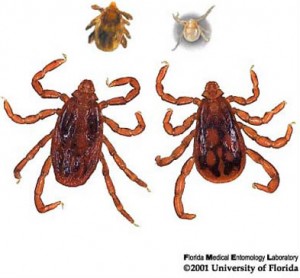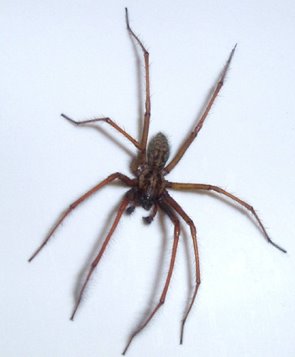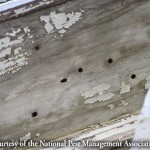READY TO GET STARTED?
REQUEST A FREE ESTIMATE
Fill out the form below or call (888) 466-7849 for a free, no-obligation estimate.
Each warm season brings questions from homeowners and pet owners regarding ticks. We worry about our furry family members and ourselves if we plan on spending time outdoors, especially in or around wooded areas.
The brown dog tick is one species of tick that should be cause for concern, especially for those who have dogs. Although they feed on a wide variety of mammals, dogs are their preferred host. These ticks are unique in that they can complete an entire life cycle indoors. They feed on the host for about a week before dropping off and laying their eggs…up to 5,000 eggs!! After she’s done laying her eggs, she dies. The full life cycle of a brown dog tick lasts just over two months and generally are long living creatures.

Tick Life Cycle – Source
A brown dog tick infestation can develop in high quantities and very quickly. Oftentimes, ticks go unnoticed on dogs until the ticks are spotted throughout the home.
To protect your home and your dog from brown tick infestation, here are some brown dog tick control tips:
For more detailed information on the brown dog tick, visit http://www.entnemdept.ufl.edu/creatures/urban/medical/brown_dog_tick.htm.
 Director of Pest Services at Northwest Exterminating, Adam Vannest, was recently featured in Pest Management Professional magazine. Adam answered some Q and A’s regarding fleas and ticks and also gave some Do’s and Don’ts for when dealing with these pesky pests.
Director of Pest Services at Northwest Exterminating, Adam Vannest, was recently featured in Pest Management Professional magazine. Adam answered some Q and A’s regarding fleas and ticks and also gave some Do’s and Don’ts for when dealing with these pesky pests.
Read below to get the full story:
Adam Vannest, director of pest services for the Atlanta area’s Northwest Exterminating, has faced plenty of hard-to-solve flea and tick problems. He recently shared tales of some memorable infestations — and his team’s solutions — with Pest Management Professional.
Q: What’s the largest flea and tick infestation you’ve faced, and how did you conquer the pests?
Vannest: One of the largest was in a rural subdivision that backed up into a large wooded area. The customer reported dealing with an intense flea problem and said she’d also noticed multiple ticks on the family dog. Seeing ticks on her children was this customer’s threshold point.
While inspecting the outside we noticed a lot of the areas around the home were overgrown. There were tall weeds and grass up against the house and woodpiles around the exterior. We started looking at the ticks’ harborage sites to figure out why they would be attracted to the location. It was a three-story house on a crawlspace, and once inside we noticed the crawlspace door was already open. There were also other entry points because it wasn’t sealed up very well. We definitely found fleas in the crawlspace. The main floor and upstairs also had fleas.
We explained to the customer that we wanted to eliminate harborage areas around the outside by cutting down weeds and trimming the grass around the foundation. We also educated the homeowner about the crawlspace and how many entry points were visible to stray animals and rodents. We had an exclusion team come out and seal up those areas so that we could treat it with a residual product and an insect growth regulator (IGR).
Next, we explained to the customer that to get our product were it needs to be we’d have to remove everything from the floor for cleaning and vacuuming. We also instructed them to take the dog to the vet for treatment. After that, we applied a broadcast treatment to the floor surfaces and throughout the house.
We had to treat the lawn for ticks as well.
Q:What’s your hardest-to-find flea and tick story. How did you solve the problem?
Vannest: It took place at a ranch house on a crawlspace. When we inspected we noticed that the family pets were pest free. This told us we were dealing with a population in the home that had been carried inside by other means.
Sometimes people forget all of the other things that can be responsible for bringing fleas into a home. Some of the hardest flea problems to solve are ones where a rodent population carries them inside.
We inspected the rest of the house and found pockets of flea activity but no defined area. However, when we got to the attic level we found a roof rat population bringing in fleas from outside, so we applied residual products and treatments there to eliminate the rodent problem. When we placed monitors to determine where flea hot spots existed we found a few more harborage sites that had been egg-laying areas. We targeted those areas and eliminated the problem.
Adam Vannest’s Dos & Don’ts
Do
■ Train technicians to always think outside the box. Every flea situation and every tick situation can be different.
■ Know your products and which ones are best for a particular infestation. Read labels and test the products.
■ Use monitoring to help find hot spots.
Don’t
■ Don’t assume the customer is doing the prep work.
■ Don’t assume every situation is going to be the same.
■ Don’t stop educating your technicians. Give them ongoing training.
You can visit Pest Management Professional magazine by going to www.mypmp.net
Note: We will link directly to the article as soon as it is available online!
 Spiders often get a bad reputation. They are creepy, crawly creatures and we fear their bite. They are often blamed for skin irritations but the fact is that 80% of presumed spider bites are actually due to some other insect bite or skin infection. Most spider bites are harmless and done by accident. However, there are spiders that can cause real harm (black widow, brown recluse). Not only can the bite be painful but the spider’s venom can cause pain as well. Non-venomous spider bite pain will typically last 5 minutes to an hour but a venomous spider bite can be painful for longer than 24 hours.
Spiders often get a bad reputation. They are creepy, crawly creatures and we fear their bite. They are often blamed for skin irritations but the fact is that 80% of presumed spider bites are actually due to some other insect bite or skin infection. Most spider bites are harmless and done by accident. However, there are spiders that can cause real harm (black widow, brown recluse). Not only can the bite be painful but the spider’s venom can cause pain as well. Non-venomous spider bite pain will typically last 5 minutes to an hour but a venomous spider bite can be painful for longer than 24 hours.
Seek medical attention if:
In rare situations, spider bites can cause allergic reaction. In this case, you should seek immediate medical attention.
If you are concerned about spiders in or around your home, call a professional exterminator to identify the problem and develop a customized plan to rid your home of spiders.

Carpenter Bee Damage Source: NPMA
There’s been a lot of buzz (pun intended) on our blog about carpenter bees and termites. It’s termite season so we always want to keep our readers aware of the potential risks and damage that termites can cause. And carpenter bees are our Pest of the Month for the month of April. Both of these wood-boring pests should be taken seriously due to the great amount of damage that they can cause.
Carpenter bees eat through soft woods where they make their nests and lay their eggs inside the tunnels. This can cause damage to decks, eaves, porches, or even support beams in your home. Luckily, they are rarely a threat to humans. Males don’t have stingers but do tend to be aggressive toward other bees, animals, or humans that are near their nests. The female carpenter bee has a stinger but rarely uses it.

Termite Damage Source: NPMA
Termites (March’s Pest of the Month) are working 24/7 to find food…and unfortunately for us, their food is typically the wood that was used to build our homes. Without termite protection, your home could be at risk for severe damage. Termites are responsible for more than $2 of damage to homes in the US each year. Like carpenter bees, termites often leave a trail of wood that can serve as a tell-tale sign that they are there.
Whether you have carpenter bees or termites, you should contact a licensed pest professional. Not only will they be able to correctly identify the insect but they will be able to develop a customized plan that is specific to your home and your situation. By doing this, you are ensuring that the problem is diagnosed correctly, that the correct product, if any, is being used correctly and safely, and that proper steps are taken to ensure that the issue does not reoccur. Northwest Exterminating and our highly trained pest professionals will be glad to come to your home and do a free inspection of your home. Just give us a call at 888.466.7849 or visit us at www.callnorthwest.com
Before that “giant” bug showed up as an unexpected guest at your first barbeque of the spring, it started off life as a tiny egg. The process of growth and development that most insects experience is known as metamorphosis. During this process, insects will change shape, form and size until they reach the adult stage. There are several different types of metamorphosis including gradual metamorphosis, incomplete metamorphosis, and complete metamorphosis.
Some insects, however, grow and develop without metamorphosis. These insects, such as silverfish, grow and develop through a series of molts. When an insect’s exoskeleton no longer stretches to accommodate its size, it must shed this exoskeleton and grown a new one, while going through an intermediate phase known as instar. Until the insect reaches adulthood, or sexual maturity, it goes through several nymph stages that have the same appearance as the adult. At adulthood, molting ceases.
The insects that experience gradual metamorphosis include cockroaches, termites, bedbugs, and earwigs. They have three distinct stages in development – egg, multiple nymph stages, and adulthood. The nymphs begin to gradually resemble the adult as they grow, but do not have wings.
During incomplete metamorphosis, which occurs for dragonflies, damselflies, and mayflies, insects experience a transition from egg to naiad to adulthood. Naiads possess a different body structure and way of life from the adults. These nymphs live in water whereas the adults live on dry land and have wings.
The last form of complete metamorphosis occurs in beetles, moths, butterflies, flies, fleas, ants, bees and wasps. They go through four stages: egg, larva, pupa, and adult. Each stage has a different appearance. The larva hatches from the egg and then goes into a resting stage known as the pupa. During this stage, the insect changes from larvae to adult and fully develops its wings, legs, and antennae before emerging.
Sources:
Georgia Pest Control Employee Registration Manual